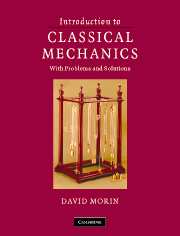Book contents
- Frontmatter
- Contents
- Preface
- 1 Strategies for solving problems
- 2 Statics
- 3 Using F = ma
- 4 Oscillations
- 5 Conservation of energy and momentum
- 6 The Lagrangian method
- 7 Central forces
- 8 Angular momentum, Part I (Constant L^)
- 9 Angular momentum, Part II (General L^)
- 10 Accelerating frames of reference
- 11 Relativity (Kinematics)
- 12 Relativity (Dynamics)
- 13 4-vectors
- 14 General Relativity
- Appendix A Useful formulas
- Appendix B Multivariable, vector calculus
- Appendix C F = ma vs. F = dp/dt
- Appendix D Existence of principal axes
- Appendix E Diagonalizing matrices
- Appendix F Qualitative relativity questions
- Appendix G Derivations of the Lv/c2 result
- Appendix H Resolutions to the twin paradox
- Appendix I Lorentz transformations
- Appendix J Physical constants and data
- References
- Index
3 - Using F = ma
- Frontmatter
- Contents
- Preface
- 1 Strategies for solving problems
- 2 Statics
- 3 Using F = ma
- 4 Oscillations
- 5 Conservation of energy and momentum
- 6 The Lagrangian method
- 7 Central forces
- 8 Angular momentum, Part I (Constant L^)
- 9 Angular momentum, Part II (General L^)
- 10 Accelerating frames of reference
- 11 Relativity (Kinematics)
- 12 Relativity (Dynamics)
- 13 4-vectors
- 14 General Relativity
- Appendix A Useful formulas
- Appendix B Multivariable, vector calculus
- Appendix C F = ma vs. F = dp/dt
- Appendix D Existence of principal axes
- Appendix E Diagonalizing matrices
- Appendix F Qualitative relativity questions
- Appendix G Derivations of the Lv/c2 result
- Appendix H Resolutions to the twin paradox
- Appendix I Lorentz transformations
- Appendix J Physical constants and data
- References
- Index
Summary
The general goal of classical mechanics is to determine what happens to a given set of objects in a given physical situation. In order to figure this out, we need to know what makes the objects move the way they do. There are two main ways of going about this task. The first one, which you are undoubtedly familiar with, involves Newton's laws. This is the subject of the present chapter. The second one, which is more advanced, is the Lagrangian method. This is the subject of Chapter 6. It should be noted that each of these methods is perfectly sufficient for solving any problem, and they both produce the same information in the end. But they are based on vastly different principles. We'll talk more about this in Chapter 6.
Newton's laws
In 1687 Newton published his three laws in his Principia Mathematica. These laws are fairly intuitive, although I suppose it's questionable to attach the adjective “intuitive” to a set of statements that weren't written down until a mere 300 years ago. At any rate, the laws may be stated as follows.
First law: A body moves with constant velocity (which may be zero) unless acted on by a force.
Second law: The time rate of change of the momentum of a body equals the force acting on the body.
Third law: For every force on one body, there is an equal and opposite force on another body.
- Type
- Chapter
- Information
- Introduction to Classical MechanicsWith Problems and Solutions, pp. 51 - 100Publisher: Cambridge University PressPrint publication year: 2008



